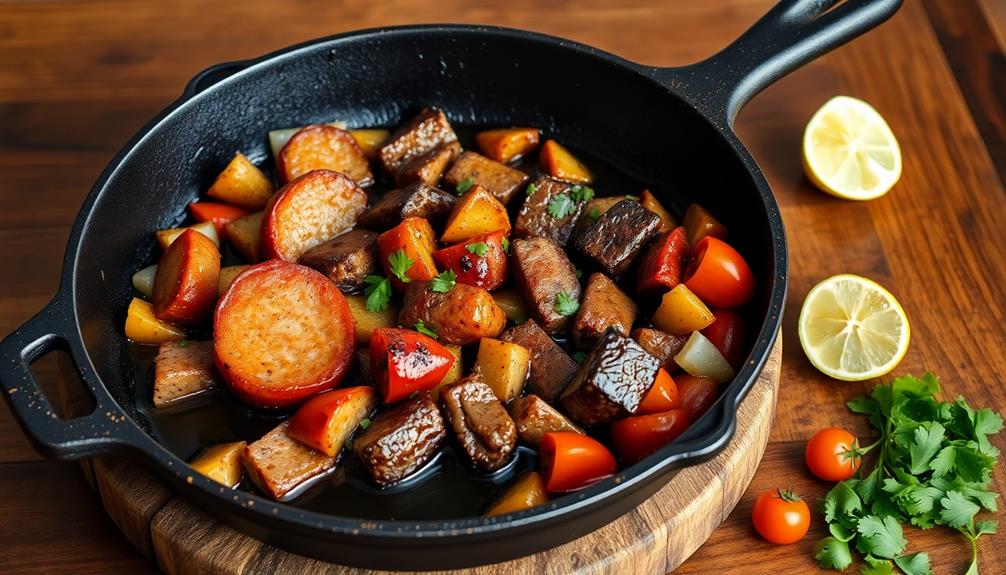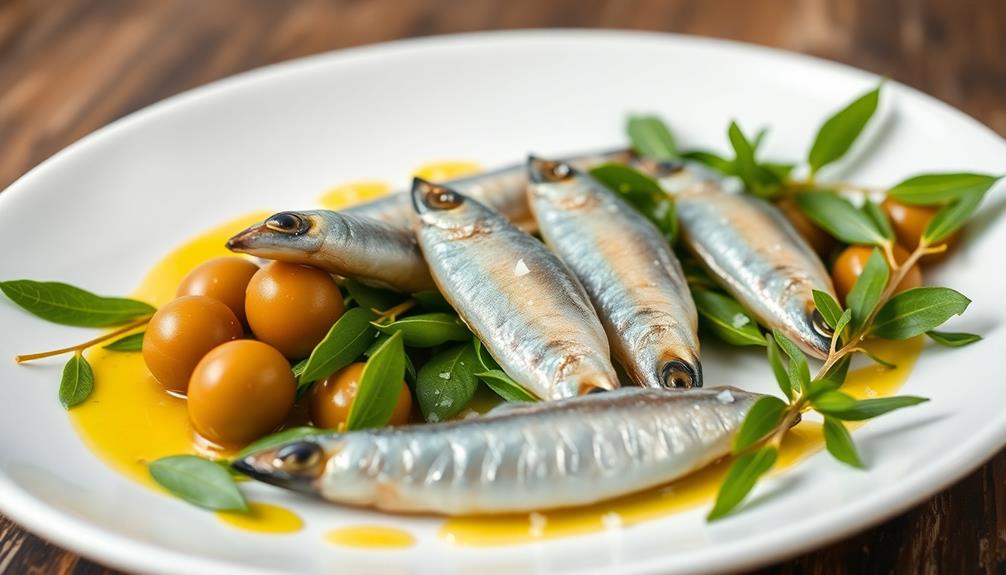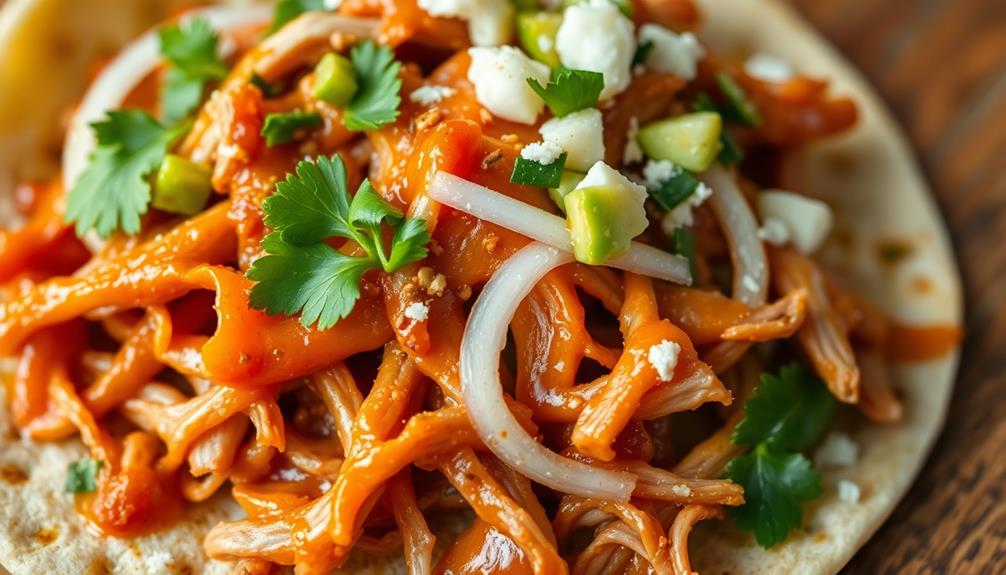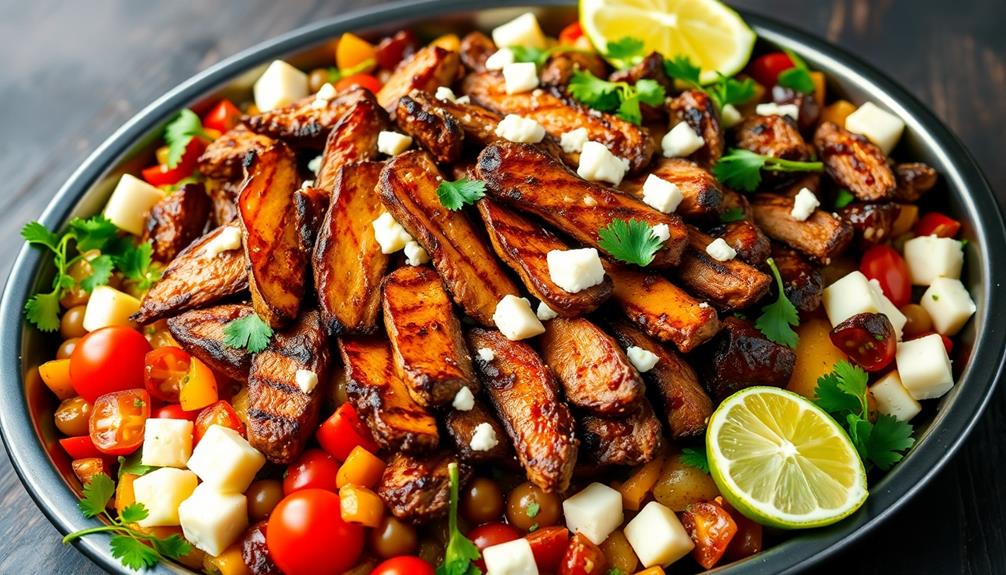You're gonna love learning about discada – it's a super cool Mexican cooking tradition! Ranch workers in northern Mexico got creative and started using old plow discs and tractor parts as cooking pans for outdoor gatherings. Discada is all about bringing family and friends together to share delicious food. You'll usually find tasty ingredients like beef, chorizo, and veggies in the pan, plus yummy spices that give it a real kick of flavor. It's perfect for cooking over a campfire or on the grill. Give it a try and you'll see why discada is such a beloved part of Mexican culture! There's lots more to discover about this unique culinary tradition.
Key Takeaways
- Discada is a traditional Mexican cooking method that uses a large, flat pan or disc for outdoor cooking over an open fire.
- It originated in northern Mexico among ranchers and farmers, and has evolved into a beloved tradition for family and community gatherings.
- The dish typically includes a combination of meats, vegetables, and seasonings, showcasing the diversity of Mexican cuisine.
- Discada encourages communal cooking and sharing of meals, with opportunities for customization and creativity in ingredient selection.
- Discada offers a variety of nutrients from its diverse ingredients, but moderation is recommended due to potential high fat content from oils.
History
The origins of the discada can be traced back to the northern regions of Mexico, where ranch workers would adapt their cooking methods to the rugged outdoor environment. They'd take an old plow disc or tractor part, build a sturdy frame around it, and use this makeshift pan to cook up delicious meals over an open fire. It was a clever solution that allowed them to whip up tasty feasts right on the ranch!
Over time, the discada became a beloved tradition, with families and friends gathering to share in the joy of outdoor cooking.
The circular shape of the pan made it perfect for sizzling up all sorts of meats, vegetables, and seasonings – from spicy chorizo to tender beef and crisp onions. The process was simple but the flavors were out of this world!
Cooking on a discada became a cherished part of the ranch lifestyle, a way to come together, enjoy good food, and make lasting memories.
Recipe
Discada is a popular dish originated in northern Mexico, known for its unique blend of flavors and cooking method. This hearty dish is typically prepared on a large metal disc or pan, which is placed over an open fire or a specialized cooking surface, allowing for even heat distribution and versatile cooking.
The traditional Discada recipe showcases the rich diversity of Mexican cuisine, combining various meats, vegetables, and seasonings to create a satisfying and memorable meal. The dish's name, "Discada," directly refers to the cooking vessel used, which is a large, circular pan or griddle.
Ingredients:
- 1 lb ground beef
- 1 lb chorizo sausage, casing removed
- 1 lb boneless chicken, diced
- 1 large onion, diced
- 2 bell peppers, diced
- 4 cloves garlic, minced
- 1 jalapeño pepper, seeded and diced
- 2 tomatoes, diced
- 1 cup corn kernels
- 2 tbsp vegetable oil
- 2 tsp cumin
- 1 tsp chili powder
- Salt and pepper to taste
- Tortillas or rice, for serving
Cooking Instructions:
In a large Discada or heavy-bottomed pan, heat the vegetable oil over medium-high heat. Add the ground beef, chorizo, and chicken, and cook until browned and cooked through, breaking up the meat with a wooden spoon as it cooks. Drain any excess fat from the pan.
Add the onion, bell peppers, garlic, and jalapeño, and sauté until the vegetables are tender. Stir in the diced tomatoes, corn, cumin, chili powder, salt, and pepper. Continue cooking for an additional 5-10 minutes, or until the flavors are well combined.
Tips:
To achieve the authentic Discada flavor, it's important to use a large, shallow metal pan or disc to cook the dish. This allows for even heat distribution and the ability to cook a variety of ingredients simultaneously.
If you don't have a Discada, you can use a large skillet or wok. Serve the Discada warm, accompanied by warm tortillas or rice, and let your guests customize their portions with their preferred toppings, such as shredded cheese, sour cream, or salsa.
Cooking Steps
First, make sure to clean and cut all your ingredients so they're ready to go.
Next, get that discada nice and hot – you want it sizzling!
Then, start adding in your ingredients and give everything a good stir to combine the flavors.
Mmm, can you already smell those amazing aromas?
Serve it up hot and enjoy!
Step 1. Clean and Cut Ingredients
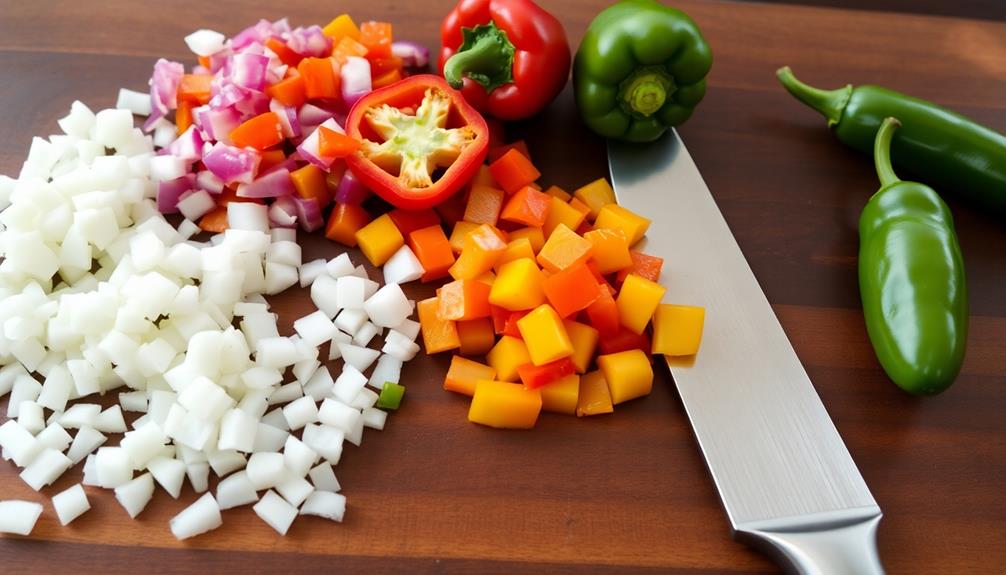
Preparing the ingredients is the initial step in crafting an authentic Discada. First, you'll need to wash all your veggies thoroughly under cool, running water. This helps remove any dirt or debris.
Next, grab a sharp knife and cutting board, then carefully slice the onions, bell peppers, and tomatoes into bite-sized pieces. Be sure to remove the seeds and membranes from the peppers for a milder flavor.
Now, let's move on to the meats. Use the knife to cut the beef and chorizo sausage into small, even cubes. This helps everything cook evenly in the Discada pan. Next, the traditional birria recipe calls for marinating the beef in a blend of chilies, vinegar, and spices for several hours. This step infuses the meat with rich, complex flavors that will truly elevate the dish. Once the meat is marinated, it’s ready to be added to the Discada pan and cooked to tender perfection.
Don't forget to peel and mince the garlic cloves – their zesty aroma will infuse the entire dish!
Step 2. Heat the Discada
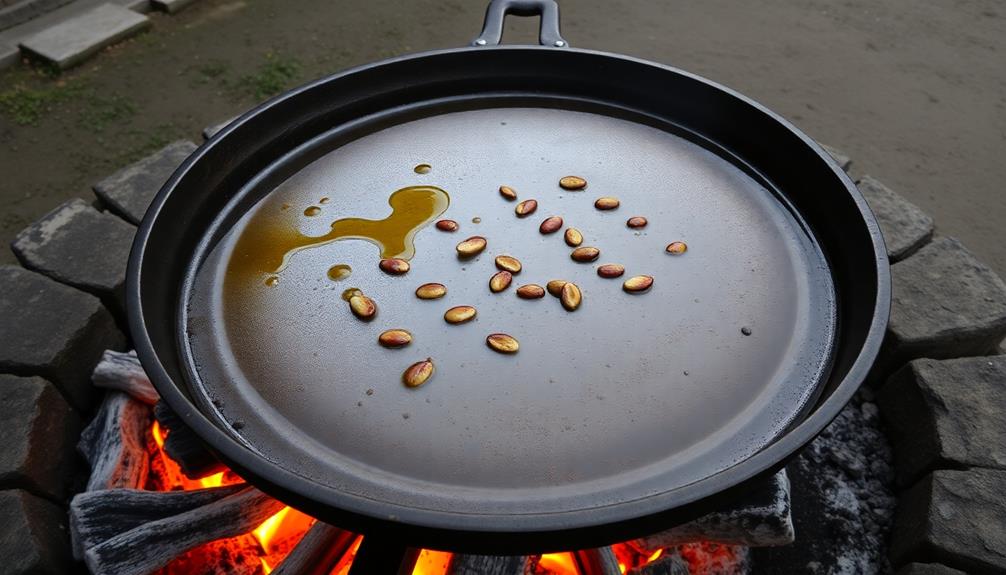
With the ingredients ready, it's time to heat up the Discada pan! Gather your tongs and prepare to get cooking.
You'll want to place the Discada pan over medium-high heat on your stove or outdoor grill. As the pan heats up, you'll start to see it shimmer and sizzle.
Next, add a tablespoon or two of oil to the pan. This will help prevent sticking and create a nice, even cooking surface.
Carefully place the prepared ingredients into the hot pan, starting with the heartier items like potatoes or corn. Listen as they make a satisfying sizzle when they hit the pan!
Stir and flip the ingredients regularly using your tongs, ensuring everything cooks evenly. The rich, savory aromas will start to fill the air, making your mouth water.
Keep an eye on the pan, adjusting the heat as needed, until all the ingredients are tender and cooked through. Get ready for a delicious Discada feast!
Step 3. Add Ingredients
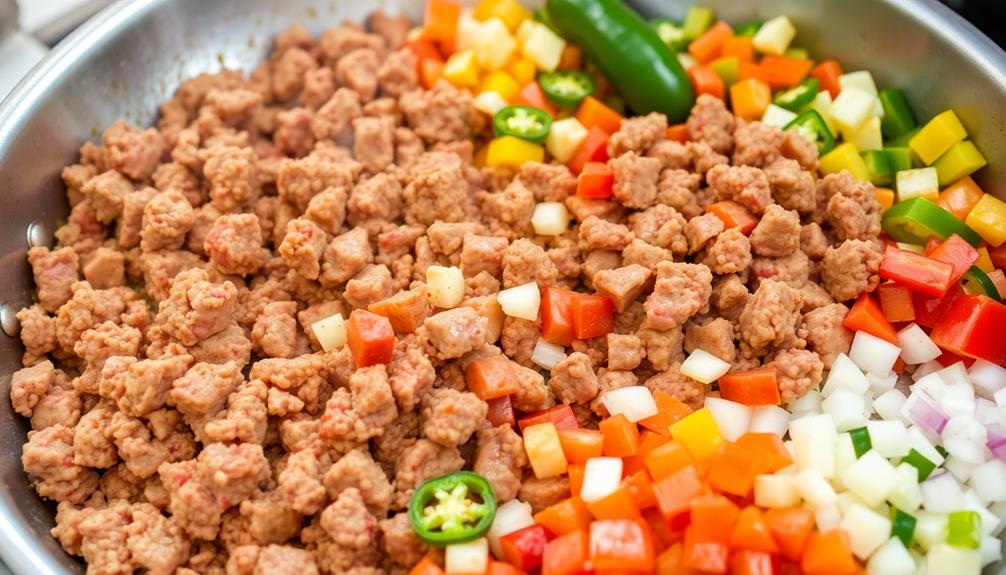
Now that the Discada pan is hot and ready, it's time to start adding your ingredients! First, grab a nice, ripe tomato and dice it up into small, bite-sized pieces. Mmm, the fresh, juicy tomato is going to add such a delightful pop of flavor to your dish.
Next, finely chop some onions and garlic – the savory aroma is already making your mouth water, isn't it?
Don't forget the protein! Slice up some spicy chorizo sausage and add it to the pan. As it sizzles, the bold, smoky flavors will infuse the whole dish.
Now, toss in some diced bell peppers in vibrant shades of red, yellow, and green. Their crunchy texture and sweet taste will balance out the other ingredients perfectly.
Step 4. Stir and Combine Ingredients
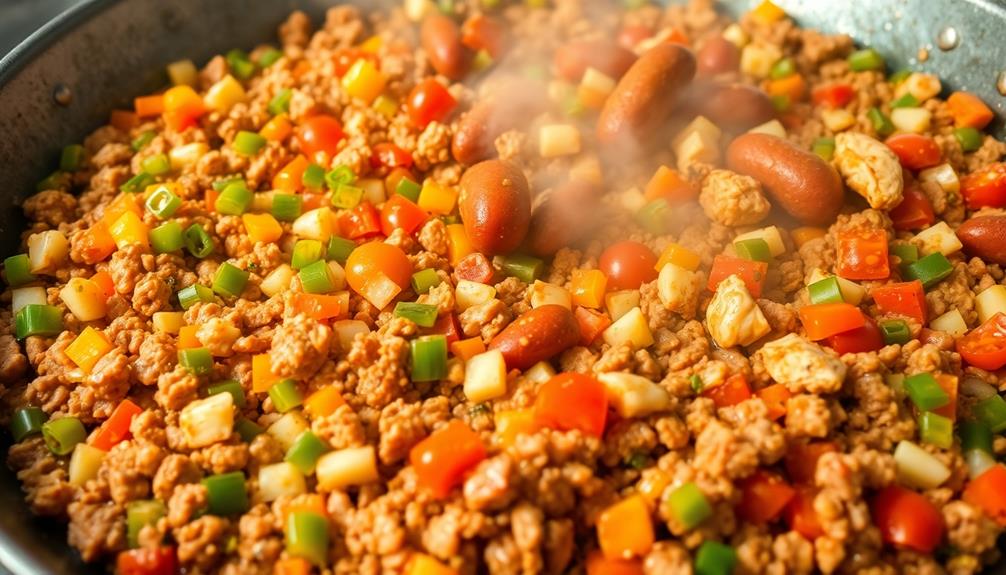
Once everything is in the pan, give it a good stir to combine all the flavors.
You'll want to make sure all the ingredients are evenly distributed and coated in that delicious sauce. Stir it up gently, but with purpose, so all the tasty bits get incorporated. You can almost smell the mouthwatering aromas wafting up already!
Now, let the discada sizzle away, stirring occasionally, until the meat is fully cooked through.
As it cooks, the flavors will meld together beautifully, creating a harmony of spices and textures. Give it a little taste test – the seasonings should be nicely balanced, with a slight kick of heat and plenty of savory goodness.
When it's all done, you'll have a hearty, flavorful dish that's sure to satisfy.
Get ready to dish it up and enjoy every delicious bite!
Step 5. Serve Immediately While Hot
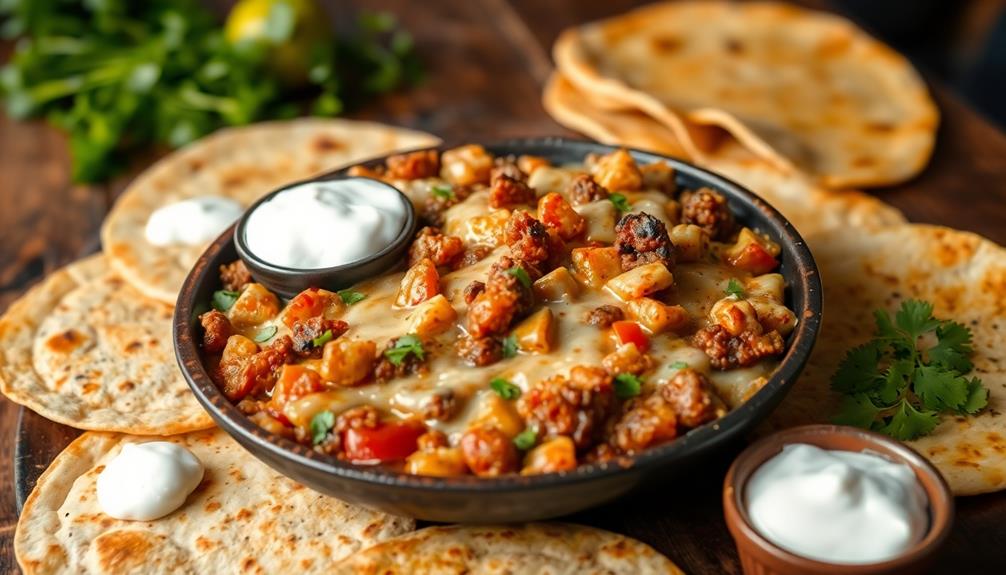
The discada is now ready to be served! It's steaming hot and bursting with all the delicious flavors you've just cooked up. Don't wait – grab your plate and dig in! The sizzling meat, the tender vegetables, and the melted cheese are just begging to be devoured.
As you scoop up a big bite, you'll be amazed by the perfect blend of spices that dance on your tongue. The rich, savory notes of the chorizo mingle with the sweetness of the peppers and onions, creating a flavor explosion that's simply irresistible.
And that crispy, golden-brown crust on the edge? It adds a satisfying crunch that takes this dish to the next level.
Serve the discada immediately while it's hot, and get ready to savor every single mouthful. This hearty, comforting meal is sure to warm your soul and leave you feeling satisfied. Enjoy!
Final Thoughts
Discada is a versatile and unique cooking method that has garnered attention from food enthusiasts worldwide. Whether you're hosting a backyard gathering or simply enjoying a cozy night in, this captivating dish is sure to impress.
The combination of sizzling meats, zesty spices, and perfectly charred vegetables creates a flavor explosion that will have your taste buds dancing with delight. As you savor each bite, you'll be transported to the heart of Mexican cuisine, where tradition and innovation collide to create something truly special.
The discada's ability to bring people together, whether family or friends, is a testament to its enduring appeal. So, why not gather your loved ones, fire up the discada, and embark on a culinary adventure that will leave a lasting impression?
Dive in, embrace the flavors, and discover the true magic of this captivating cooking method.
Frequently Asked Questions
What Equipment Is Needed to Make a Discada?
To make this dish, you'll need a large, shallow pan or griddle, cooking oil, and your choice of meats, vegetables, and seasonings. Gather these essential items, and you'll be well on your way to creating a delicious meal.
How Long Does It Take to Prepare a Discada?
Depending on the complexity of your dish, preparing it can take anywhere from 30 minutes to several hours. You'll need to factor in time for chopping ingredients, cooking, and assembling the final product.
Can a Discada Be Made Vegetarian or Vegan?
You can absolutely make a vegetarian or vegan version of this dish. Simply swap out the meat for plant-based proteins and adjust the seasonings to suit your dietary preferences. It's a versatile option that can accommodate various dietary needs.
How Do I Clean a Discada After Use?
After using your cooking surface, let it cool completely. Then, use a stiff-bristle brush to scrub off any food residue. Rinse with warm water and dry thoroughly to prevent rusting. Store your equipment in a dry place until next use.
Where Can I Find the Specific Ingredients for a Discada?
You can find the specific ingredients for your dish at your local grocery store or specialty market. Look for the necessary meats, vegetables, and seasonings to create the flavors you desire. Don't be afraid to experiment with different ingredients.
